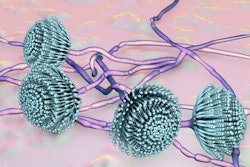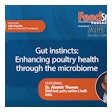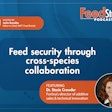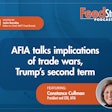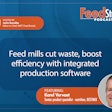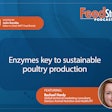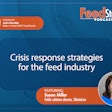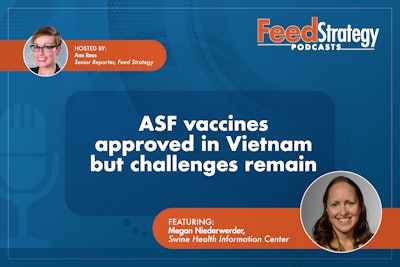
ASF vaccines approved in Vietnam but challenges remain (13:29)
Ann Reus: Hello and welcome to the Feed Strategy podcast. I’m your host, Feed Strategy senior reporter Ann Reus.
Megan Niederwerder is associate director at the Swine Health Information Center, or SHIC. She recently joined me to talk about developments in the production and distribution of two African swine fever vaccines in Vietnam. We discussed the vaccines, how they will be administered, and what challenges they bring. We also talked about her upcoming transition to executive director at SHIC and what she’s looking forward to in her new role. Here’s our conversation.
Hi, Megan. It’s so nice to have you back on the podcast.
Megan Niederwerder: It’s nice to be here. Thanks for having me.
Reus: We’ve recently learned that Vietnam has approved two vaccines for African swine fever to be used for domestic use. What can you tell me about these vaccines – how were they developed, and how safe and effective are they?
Niederwerder: Yeah, this is really a groundbreaking new development in that the Ministry of Agriculture and Rural Development in Vietnam has officially approved the domestic commercial use of these two locally manufactured vaccines against ASF. This is really big news, of course, for control of the virus, and also big news for the work and research that Vietnam has been doing on these two vaccines. There’s really two primary vaccines that they of course have been working on and that were recently approved. They’re both modified live virus vaccines and they both have gene deletions, meaning from the wild type virus from the ASF Georgia strain. These two vaccine candidates have different genes that have been deleted from the wild type virus to make them attenuated, meaning that they do not cause clinical disease in pigs and can provide protection against the wild type virus when exposed. So, this is very exciting news for of course, for swine production worldwide. And, in particular, these two companies that are creating the vaccines.
Reus: How will the vaccines be produced and distributed in Vietnam?
Niederwerder: Yes, right now, te Vietnam’s agriculture ministry has requested that these two vaccine companies so it’s AVAC and NEVETCO, these two companies that are producing these vaccines, to start devising production plans for both domestic sales and potential export. So they’re looking, of course, at the population domestically in Vietnam, approximately 28.6 million pigs in Vietnam. So looking, of course, at that market, and then also looking at potential export to other countries that are currently struggling with African swine fever virus outbreaks, which may be interested in implementing either a vaccine control strategy, or of course just having the vaccine available in their toolbox for ASF strategies.
Reus: Any idea what the timeline would be for production and distribution?
Niederwerder: Well, they have already had quite a bit of field evaluation of these two vaccines. So the NAVETCO vaccine has been distributed and doses have been administered, about 47,000 doses to pigs for that NAVETCO vaccine, and about 605,000 doses of the AVAC vaccine have been administered. That’s really gone on over the last year in these field evaluation trials to understand the efficacy and the safety and the effectiveness of these vaccines, up to now, of course, and now that they’re been commercially approved. And so they have that production capacity, of course, with these large doses that have already been administered in the field evaluation. And of course, we’ll have to see how that ramps up now that the commercial use has been approved. And of course, they’re considering more export potential.
Reus: Do you think demand for these vaccines in Vietnam will be high and, if so, how will the producers keep up with demand?
Niederwerder: Yeah, we’ve seen that Vietnam has continued to struggle with introduction of ASF outbreaks into new areas or new farms in the country. Certainly, I think farmers and producers will be looking at the commercial availability of these vaccines as an important tool for their ASF control strategies. And it of course needs to be coupled with the biosecurity practices that these farms are already considering, such as inputs, such as feed and supplies and personnel biosecurity, and water biosecurity and everything that the Vietnam producers are considering for their ASF control strategies. But absolutely, I think they will be looking at the availability of these vaccines is another tool to help control ASF in their herds to hopefully help with potential ASF eradication, regionally or in the country. And we see that the reports are stating that each vaccine will be approximately $1.80 per dose. These doses will be available for purchase by farmers and producers, and of course, will be evaluated in coordination with their veterinarian for particular use in the appropriate age group.
Reus: You’ve mentioned exports; will they be distributed anywhere else? We’ve reported that the Philippines is preparing to receive and distribute the vaccines, but there are concerns about that country’s ability to do so.
Niederwerder: Yes, we’ve certainly seen reports of the two ASF vaccines in Vietnam with regards to plans for export to certain countries. We’ve seen that the Philippines has reported their interest and plans to import the AVAC vaccine. And we’ve also seen reports from the Dominican Republic for plans and use of the NAVETCO vaccine in a small-scale trial study. And so yet to be determined as far as how broadly or how widely these vaccines will be utilized after production ramps up in Vietnam, and of course, there are additional ASF vaccine candidates that continue to be investigated and evaluated for their potential use. But certainly these two vaccines AVAC and NAVETCO in Vietnam, as the first commercially available vaccines, certainly are ahead of the market as far as availability and potential for export.
Reus: The two vaccines have different guidelines for the age at which they should be administered. Do you have any insight as to how this will be monitored to ensure the vaccines are being given safely and correctly?
Niederwerder: Yes, certainly it’s important that we consider that the AVAC and the NAVETCO vaccines have been evaluated and are recommended in different age groups. The AVAC vaccine, for instance, is recommended for administration of pigs that are four weeks of age or older. And the NAVETCO vaccine has been recommended for administration of pigs eight to 10 weeks of age. There’s also a difference in the duration of immunity between each vaccine. So the AVAC vaccine has shown that the duration of immunity is approximately four months, whereas the NAVETCO vaccine has shown a six-month duration of immunity. And those have been measured by antibodies produced by the ASF vaccine, as measured by ELISA. And so when you think about these two vaccines and the differences in recommended age of administration, and of course the trials that have confirmed safety and efficacy in those pig groups, it will be really important as individuals use these vaccines to be in coordination with veterinarians and producers to ensure that the appropriate age pig receives the vaccine to again help in those ASF control strategies.
Reus: What are some other challenges concerning these vaccines?
Niederwerder: There are a few continued challenges with these vaccines, one of which is that we don’t have a lot of information about the safety and efficacy in age groups or in breeding animals outside of those recommended administration groups. And that continues to be a question that will be investigated and confirmed, of course to understand the potential use in other age groups or in breeding animals.
A second challenge is that there continues to be a lack of a DIVA test for antibodies, meaning that if you took a blood sample from a pig and detected ASF antibodies, you would not be able to distinguish those antibodies between animals that were vaccinated and animals that were naturally infected. And that becomes really important as far as a control strategy and a tool when you’re thinking about eradication or elimination of disease and the use of vaccine to control disease, making sure you can differentiate again from infected and vaccinated animals.
The other challenge that’s really been highlighted in use of these vaccines is that we currently do not have an effective molecular surveillance system to monitor the circulation of both wild type and vaccine variants in the pig population. That will be really important to understand the virus’ dynamics, and the vaccine efficacy with regards to wide-scale use of the vaccine and continued outbreaks of the wild type virus or introduction into those vaccinated populations.
The last challenge that we’ve highlighted is thinking about the need to establish a sustainable plan for documenting and assessing the vaccines’ effectiveness in these real-world scenarios. We know that the more the vaccine is used in Vietnam and in other countries, the more populations are going to be exposed to the vaccines that for instance, have co-infections of other pathogens, and certainly that may affect the vaccines’ ability to protect against wild type ASF. And the more information we can gather during the vaccine use, the more of course, we will be able to learn about the potential strategies with regards to vaccination, and how that can be used in best-case scenarios to really reduce the ASF risk and burden around the world.
Reus: Lastly, I don’t want to let you go without congratulating you on the upcoming promotion. You’ll be taking on the role of executive director at the Swine Health Information Center on January 1, after Paul Sundberg retires at the end of this year. How are you feeling about this new chapter and what are you looking forward to?
Niederwerder: Well, thank you for mentioning the promotion. Yes, I’m thrilled to take on leadership in the Swine Health Information Center. And of course, Paul Sundberg has done a fantastic job in leading this organization, really since its inception in 2015. And I look forward to continuing to work with producers and veterinarians and researchers to really identify new tools and novel control strategies for emerging diseases in the swine industry. SHIC is absolutely laser focused on emerging diseases and preparedness and prevention and response planning, and I really look forward to continuing to work towards SHIC’s mission. And of course, the other aspect of this is that we are currently looking for a new associate director to join our team at the Swine Health Information Center, and of course, if any of your listeners are interested in that, we have more information on our website.
Reus: OK, great. And we’re looking forward to seeing what happens in the future at SHIC as well. Megan, thank you so much for joining me again and talking this all through.
Niederwerder: Thank you so much for having me.
Reus: And thank you to the audience for listening. I’m Ann Reus for Feed Strategy.



